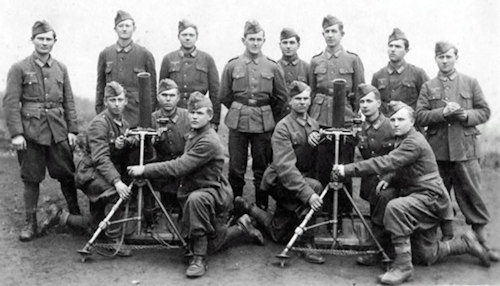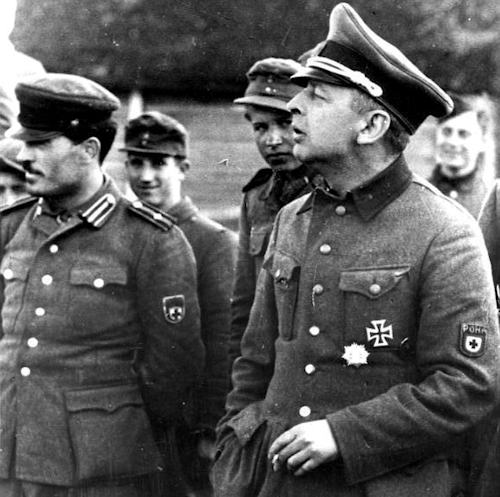During the Second World War, Hitler's Germany engaged in an all-out struggle with the Soviet Union which largely went beyond the confines of a mere "clash of power" until it turned into a real "struggle for survival" on both sides. Nonetheless, it is interesting to note that throughout the period between 1941 and 1945, over 1 million former Soviet citizens actively collaborated with the Germans and their Axis allies in one way or another.
In this panorama, a significant role was played by the "Russian" collaborationist units which, moreover, were the only ones to be equipped with their own autonomous armored component. Curiously, the first of these "Russian units" originated not in the Soviet Union but in Yugoslav territory.
After the destruction of the Kingdom of Yugoslavia by the Axis forces, a group of ex-tsarist officers characterized by pro-German and strongly anti-communist political leanings created the so-called Russian Independent Corps which, after a series of transformations, acquired a divisional dimension and was absorbed by the Wehrmacht with the name of Russian Protective Corps in Serbia. The ranks of this division were filled by drawing volunteers from the anti-Soviet Russian émigré communities scattered throughout the area of Yugoslavia (especially in Serbia).
At its peak, the RSS (Russisches Schutzkorps Serbian) numbered around 12.000 men (although those who served collectively were many more) and were equipped with a number of French Hotchkiss H39 prize tanks. The RSS was used throughout the war in operations against the Yugoslav partisans and, later, its members were meted out to the same fate as Tito reserved for traitors to Yugoslavia. However, the most important pool available to the Germans to find "collaborators" was undoubtedly the vast population of Soviet prisoners of war who languished in concentration camps in the Third Reich and the rest of Europe following the devastating German victories in the first phase of the war against the eastern enemy. Many of these Soviet POWs (although NEVER THE MAJORITY) were tempted to accept the German offers of collaboration both to escape the appalling conditions of prison camp life and out of hatred for the Soviet regime which they held responsible (not quite wrong!) of their miseries.

While the recruitment of volunteers belonging to the most disparate ethnic minority groups proceeded expeditiously and both the Wehrmacht and the Waffen-SS were able to round up numerous recruits with which to form different legions and divisions, this was not so true with the "ethnic Russians" since Hitler was strongly against seeing those he considered "the quintessential subhumans" (along with the Jews) fighting side by side with the Germans. Despite this hostility on the part of the leadership, the problem was slowly overcome at lower levels.
As in other cases, the quickest to take advantage of the situation were the Waffen-SS which already at the end of 1941 created an auxiliary police unit under their control in an area between the Soviet oblasts of Bryansk, Orel and Kursk. The unit initially numbered just 200 men but later grew to a sizeable 10-12.000 men under the command of Bronislav Vladislavovich Stroganof Kaminski and was officially known as SS Sturmbrigade (SS assault brigade). Colloquially known as "Kaminski Brigade" (from the name of its commander), over time it was renamed "RONA" (acronym that stands for "Russian People's Liberation Army"), however it never had the function that the high-sounding name left understand, in fact even at the time of its maximum "splendor", it was nothing more than a band of assassins used by the Waffen-SS for anti-partisan operations and to spread pure terror among the civilians of the eastern European lands, as happened for example during the Warsaw uprising, between 1 August and 2 October 1944, when it was precisely the men of the "Kaminski Brigade" together with those of the penal brigade of the Waffen-SS "Dirlewanger" (commanded precisely by Oskar Paul Dirlewanger) who commit the most heinous acts of cruelty against Polish partisans and civilians.
During its almost three years of existence, in order to better fulfill its task as an anti-partisan unit and to enjoy a comfortable advantage in firepower, RONA was also assigned an armored unit consisting of 1 KV-1 heavy tank, 8 T-34 tanks (opening photo), 5 BT light tanks and some armored cars.

After distinguishing himself in the suppression of the Warsaw uprising, Bronislav Kaminski (photo) was accused by the high ranks of the SS of taking advantage of his position to plunder the goods of the populations that his men terrorized and, subsequently, shot together with the entire general staff of its unit. The remnants of the "Kaminski Brigade" were disbanded and absorbed into another "Russian" unit that Germany was creating at that time: TheRussian Liberation Army (better known as “ROA”).
The ROA was officially born at the end of 1944 to serve as the army of the KONR, an acronym which stands for "Committee for the Liberation of Peoples of Russia". General Andrey Andreyevich Vlasov was placed at the head of this last organization, founded in November 1944 under the impulse of the Germans; once a rising star in the Red Army who turned collaborator after his capture by the Germans on the Leningrad front in June 1942.
In the short span of its existence, the ROA managed to establish only 3 divisions:
- the 600a Russian Infantry Division, with 20.000 soldiers;
- the 650a Russian Infantry Division, with 12.000 soldiers;
- the 700a Russian infantry division, with 10.000 soldiers.
Overall, the ROA experience could be summed up with the expression “too little too late”. Although at the end of 1944 there were 800.000 ex-Soviet citizens under arms in the ranks of the Wehrmacht and the Waffen-SS, both institutions proved to be extremely hostile to the prospect of "giving up" their "soldiers of Soviet origin" to the nascent ROA so much so that, at the end of the conflict, only one of the 3 divisions of the ROA, the 600th, under the command of general Sergey Kuzmich Bunyachenko had become fully operational. And it was precisely this that received an important albeit small armored component. It was originally made up of a small number of T-34 tanks and BA-10 armored cars, but after the division was able, in early February 1945, to distinguish itself in the fights against the Soviet bridgehead of Neulowin, it was “rewarded” with the sale of 9 T-34 tanks, 2 SU-85 assault guns, some BA-10 armored cars and, above all, a tank destroyer company of 10 Jagdpanzer 38(t) Hetzer.
In any case, the Second World War was almost over and the soldiers of the ROA, squeezed between the Third Reich and the Soviet Union, were like the damned just waiting for their final condemnation.
Enraged by years of humiliation at the hands of the Germans, ROA officers, especially General Bunyachenko, disobeyed suicide orders from the German High Command and led their men into Czechoslovakia where, in a final side-by-side battle with the partisans of the Czechoslovakian resistance, contributed significantly to defending Prague from the attempt by the Waffen-SS to raze it to the ground as they had done with Warsaw the year before, after which they met their inevitable end at the hands of their ex-comrades of the victorious Army Red.
Photo: web / Bundesarchiv












